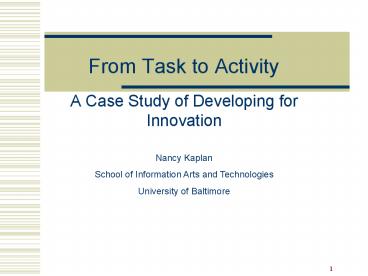From Task to Activity - PowerPoint PPT Presentation
1 / 34
Title:
From Task to Activity
Description:
3 Varieties: Situated Action, Distributed Cognition, and Activity Theory ... determining human action are just a few of the issues that are neglected [in the ... – PowerPoint PPT presentation
Number of Views:157
Avg rating:5.0/5.0
Title: From Task to Activity
1
From Task to Activity
- A Case Study of Developing for Innovation
Nancy Kaplan School of Information Arts and
Technologies University of Baltimore
2
UCD Considered Harmful
- Edsger Djikstra
- Go To Statement Considered Harmful, Letter to
the Communications of the ACM, 1968 - Part of an effort to develop formal verification
for programs, structured programming movement - Now in the ACMs hall of fame
3
Normans Beef
- Wants to provoke reconsideration of HCD
fundamentals (as in standard user and task
analysis methods) - Activities are larger than tasks
- Users are various and form moving targets
- These methods cant lead to innovation
4
So Whats ACD?
- 3 Varieties Situated Action, Distributed
Cognition, and Activity Theory - Provide alternatives to traditional cognitive
science and information processing models of the
human beings role in relation to computers or
other technical systems - Focus on context (whatever that is)
5
A Brief History of ACD
- From Human Factors to Human Actors, Liam
Bannon, 1991 - Within the HF approach, the human is often
reduced to being another system component with
certain characteristics, such as limited
attention span, faulty memory, etc., that need to
be factored into the overall human-machine
system.
6
A Brief History of ACDBannon, cont.
- This form of piecemeal analysis of the persona
as a set of components de-emphasizes important
issues. Individual motivation, membership in a
community of workers, and the importance of
setting in determining human action are just a
few of the issues that are neglected in the HF
approach.
7
Three Questions
- Whats the difference between UCD and ACD?
- Does the difference make a difference?
- If so, how can we put ACD into practice?
8
Bannons Conclusions
9
Differences
- Lab experiments v. observation in real settings
- See A. Dillon Designing Usable Electronic
Text for an overview of research on reading from
screens - Errors and inefficiencies v. whole user
experience - Initial steps of usage v. actual, long-term use
- Human actions v. human activities
10
Activity Theory in a Nutshell
- Beyond actions gt rich context
- Activities key units of analysis
- Actions occur only in contexts and without their
contexts actions in themselves are impossible to
understand. - See Kuutti, K., A Framework for HCI
Research in Nardi, B. (ed), Context and
Consciousness, MIT Press, 1996.
11
Activity Theory in a Nutshell
- Activities undergo continuous change and
development they are contingent and emergent,
not fully planned - Activities always contain artifacts
- Examples of artifacts instruments, signs,
procedures, machines, methods, laws, forms of
work organization - Activities are composed of subjects (actors),
objects (motives or goals), actions (tasks), and
operations (methods and selection rules in GOMS
terms)
12
Do the differences matter?UCD Reading
- Reading as task
- Locate desired text (search bookshelves)
- Display it (pick it up)
- Decipher it (make sense of letters, words,
sentences) - Navigate it (turn pages)
13
Do the differences matter? ACD Reading
- Reading as activity
- Define the object of reading pleasure,
enrichment, knowledge - Find text in the context of the readers object
- Undertake necessary actions (display, navigate,
decode, make sense) in a sanctioned or preferred
setting - Participate in the community of readers, knowers
14
Exploring implications with case studies
- Look at three interfaces for reading books online
- Examine the findings from contextual inquiry and
compare to the findings from participatory and
iterative design - Look at results of use in the wild
15
(No Transcript)
16
(No Transcript)
17
(No Transcript)
18
(No Transcript)
19
(No Transcript)
20
(No Transcript)
21
Contextual Inquiry Informants UCD for Reading
- Kids reading as a leisure activity do it at home,
mostly, often in their bedrooms, often in bed - If they talk about books, they do it with parents
not peers - They know they are not allowed to make marks in
books
22
Participatory Design Partners ACD for Reading
- Kids envision dynamic books searchable,
supporting link lists, providing sounds - Kids explore leaving marks in books and sharing
with friends - Kids explore interfaces to represent the presence
of other readers within the book display
23
(No Transcript)
24
Interfaces for Reading What the Book Should Look
Like and Do
25
(No Transcript)
26
(No Transcript)
27
Reading in the Wild Two Case Studies
- Designing for the activity of reading leads to
innovation - The novel situation of reading changes reading
practices
28
Reading in the WildPart One
- Design partners and their parents read a book
with Alph - WARNING Tiny n!16 participants (7 youngsters
and 9 adults) divided into 6 Internet Reading
Groups - Kids as designers much better with the system
than their parents - We see the first signs of sociable literacy
29
Reading in the Wild Part Two
- Volunteers solicited by the Corvallis
Benton-County Public Library - Tiny n, zero gender balance, small age range!
- Using Alph, participants read a book, chosen by
the childrens librarian, for 4 weeks - We gather data from the systems logs and from
discussion with participants
30
(No Transcript)
31
(No Transcript)
32
(No Transcript)
33
A Close-up Reading with Alph
Amethysts activities during one reading session
34
Coming Back to Earth
- Ok, so ACD works in practice, but will it work in
theory? - A new framework for what were doing?
- A new marriage of town and gown?
- How can we apply ACD in the real world and for
what problems is it appropriate?































